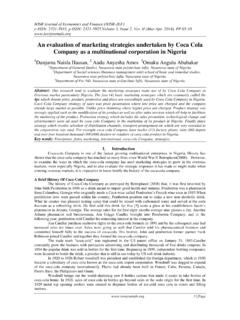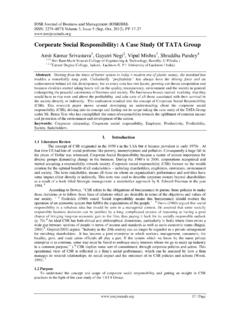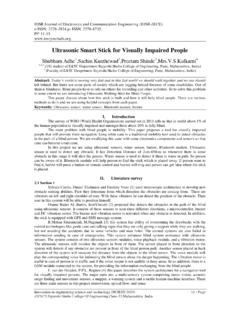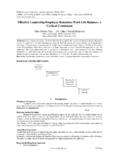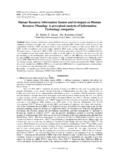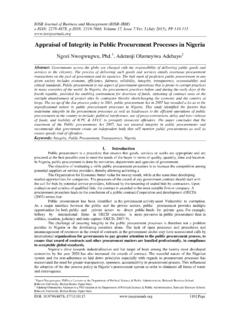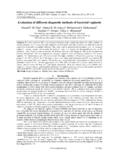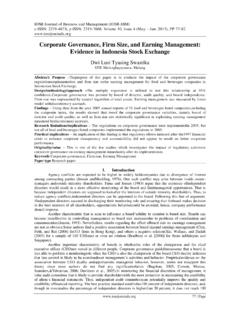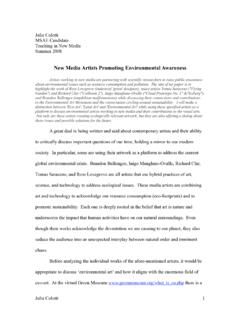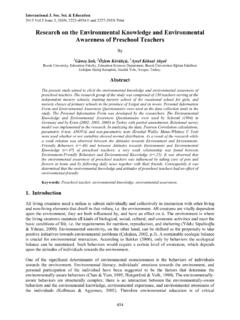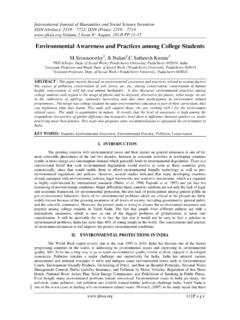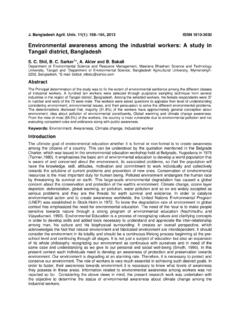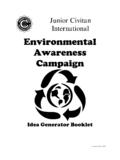Transcription of Environmental Awareness Among Secondary ... - IOSR Journals
1 IOSR Journal Of Humanities And Social Science (IOSR-JHSS) Volume 19, Issue 3, Ver. II (Mar. 2014), PP 30-34 e-ISSN: 2279-0837, p-ISSN: 2279-0845. 30 | Page Environmental Awareness Among Secondary School Students Of Golaghat District In The State Of Assam And Their Attitude Towards Environmental Education Kumud Ghosh, Assistant Professor, Education Department, Nakachari College, Nakachari 785635, Jorhat Assam. Abstract: The present study attempts to study the level of Environmental Awareness and attitudes towards Environmental education Among Secondary School students of Golaghat district in the state of Assam. The sample consisted of 200 students which includes 100 boys and 100 girls. The Descriptive Survey Method was employed for the present study.
2 Environmental Awareness , attitude and socio-economic scale was developed and standardized for the present study. The data was statistically analyzed by using z test and Karl Pearson s coefficient of correlation ( r ). Environmental Awareness and attitude towards Environmental education Among the Secondary School male and female students was found not significant; but in case of rural and urban student the attitude towards Environmental education was found significant. The relationship between Environmental Awareness and attitudes towards Environmental education Among the students was found strong and positive. Key Words: Secondary School, Environmental Awareness , Attitude, Socio-economic status. I. Introduction: Mankind s encounter with the environment is as old as the man himself. Since the evolution of man on the earth he has been dependent on the environment.
3 Initially need of man limited and small; therefore, the activities of man did not affect the environment. But slowly human being settled down and civilized himself and learnt to cultivate. Over recent decades, global problems relating to degradation of natural resources and pollution have increased dramatically. Natural resources are depleted by excessive use. Environment is the sum total of all conditions and influences of the development of the life of human being and other organisms. It includes air, water, land dynamically the interrelationship that exists between these and human beings; other living creatures, plants, microorganisms and property. The word environment embraces the conditions or influences under which any organism or thing exists, lives or develops. All these may be placed into three divisions such as the set of physical conditions affecting and influencing the growth and development of an individual and community; the social and cultural conditions affecting the nature of an individual or community; and the surroundings of an inanimate object of intrinsic social value.
4 Therefore, environment includes all the conditions, circumstances and influences surrounding and affecting an organism or a group of organisms (Trivedi and Raj, 1992). So, it may be stated that the concept of environment in its totality is a complex one, far ranging in its implications and challenging to our understanding. Over the last 50 years, Environmental education (EE) has been one of the main interests of school organizations, local communities, the private sectors and local governments. These organizations have been demanding that schools should include EE in the curriculum of education. Many authors name the 1960s as the decade when EE started to develop in response to the world s growing Awareness about Environmental problems. Others believe that EE grew from the movement that existed from the beginning of the last century such as nature study, conservation and outdoor education (NACD, 1998).
5 One of the most widely accepted definitions of EE was given in the Tbilisi Declaration which was developed at the international conference of environment educators, sponsored by UNESCO in 1977. Environmental education was defined there as learning process that increase people s knowledge and Awareness about the environment and associated challenges, develops the necessary skills and expertise to address the challenges, and fosters attitude, motivations, and commitments to make informed decisions and take responsible action (UNESCO, 1978). According to this declaration, Environmental education is seen as a life-long process that is interdisciplinary and holistic in nature and application. It concerns the interrelationship between human and natural systems and encourages the development of an Environmental ethic, Awareness , understanding of Environmental problems, development of critical thinking and problem solving skills.
6 MacGregor (2003) believes that the Tbilisi definition was based on the definition developed by Stapp et al. (1969), because William Stapp influence in creating and shaping the Tbilisi EE conference (Bartosh, 2003). Environmental Awareness Among Secondary School Students Of Golaghat District In The 31 | Page The term Environmental Awareness has a broad meaning. It not only implies knowledge about environment but also values and necessary skills to solve Environmental problems. Moreover, Environmental Awareness is the initial step ultimately leading to the ability to carry on responsible citizenship behaviour (Sengupta, Das and Maji, 2010). Environmental education is a process of identifying values and clarifying concepts in order to develop skills and added tools necessary to understand and appreciate the inter-relationship Among man, his culture and his bio-physical surroundings.
7 A number of research works have been taken up in this respect. But being a location specific issue, research on Environmental education should be undertaken in different parts of the country for developing a clear understanding and perspective of the issues involved. Rajput et al. (1980), made an attempt to identify the Awareness of children of primary level, towards the scientific and social environment. The study revealed that only one of the four group (2 schools X 2 Class) were significantly different on Environmental Awareness at pretest stage, whereas at the post test stage two experimental group were significantly better than the control group Paramjit (1993) conducted a study on Environmental Awareness Among the student of Different Socio-Economic status . The finding revealed that Environmental Awareness was more Among boys of better socio-economic status whereas Among girl, it was observed that the girls of lower socio-economic status had more Environmental Awareness as compared with boys.
8 Study of Sebastian and Nima (2005) showed that science students have more Awareness of biodiversity and its conservation than other students. Fisman, L. (2005), Study Showed that the local Environmental Awareness found only Among students living in high socio-economic neighborhoods. II. Justification of the study: Over recent decades, global problems relating to degradation of natural resources and pollution have increased dramatically. Natural resources are depleted by excessive use. Fresh water scarcity on a global scale, deforestation, degradation of river areas, soil depletion and loss of biodiversity, are some of the problems that have become a major concern. Air and water pollution have reached such levels that have already resulted in serious health problems, as well as negative impact on the environment, and inevitably influencing prospects for long-term economic growth.
9 Awareness is essential to solve these problems. On the otherhand, without a positive attitude towards Environmental education as subject, our Secondary schools will not be able to motivate our future generation to take environment related problems as challenge. That's why the present venture had been made in this direction to study the Environmental Awareness and attitude towards Environmental education Among the Secondary School students. Objectives of the Study: Major objectives of the present study are:- 1. To study the Environmental Awareness and attitude towards Environmental Education of Secondary School students of Golaghat district in the state of Assam. 2. To study the Environmental Awareness and attitude towards Environmental Education of rural and urban Secondary School students of Golaghat district in the state of Assam.
10 3. To find the relationship between Environmental Awareness and attitude Among the Secondary School students of Golaghat district in the state of Assam. 4. To find the relationship between Environmental Awareness and socio-economic status, Environmental Awareness and academic achievement Among the Secondary School students of Golaghat district in the state of Assam. 5. To find the relationship between Environmental attitude and socio-economic status, Environmental attitude and academic achievement Among the Secondary School students of Golaghat district in the state of Assam. Hypothesis of the Study: 1. There is no significance difference in the Environmental Awareness Among the Secondary School male and female students of Golaghat district in the state of Assam. 2. There is no significance difference in the Environmental Awareness Among the rural and urban Secondary School of Golaghat district in the state of Assam.
